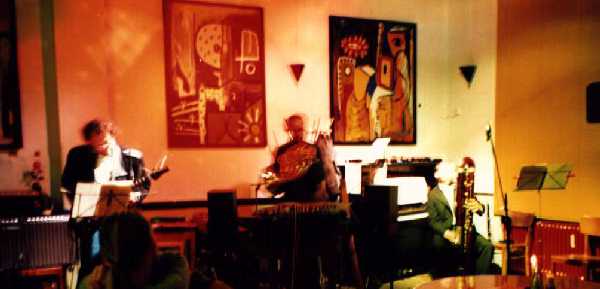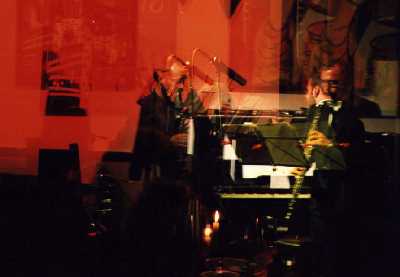

The Tranquil Club left its marks in the late 80ies/early 90ies in the
Ruhrgebiet, a large conglomerate of towns right in the middle of (former)
West-Germany. The members of The Tranquil Club only had one quest: to play
music to as few people as possible as silently as possible. It started
with an idea by Brian Eno, who fancied to have a house or a club with a
few circles of rooms, adding more and more quietness and silence when entering
the next circle. The Tranquil Club did not have a house, but tried to put
this idea on stage. The first event of The Tranquil Club took place in
Bochum, in a room very well suited for the occasion. It had the shape of
a cocoon, lots of soft and colourful lights and the floor was laid out
with soft material. You could walk around without being heard. Events of
The Tranquil Club did not last for one evening, they lasted for 5 nights.
Music was created, the stage was lightened by TV-Sets that were put up
on their sides or on their top, switched to near invisibility or just a
mess of colours. The sound system had 6 channels with different sounds
coming out of each channel, there were films and tapes. Even the main evening
news from Germany's leading TV station were an integral part of the show,
slightly distorted by very low-level sounds. Words were spoken, films were
accompanied, stories were told, pictures were taken, sounds came from everywhere.
It was very strange, sometimes entertaining, sometimes not. The Tranquil
Club even made it onto nationwide radio in Germany when it took hold of
the airwaves for one whole hour.

One of the rules in the creation of The Tranquil Club was to discuss
everything endlessly but to play with real instruments and make music with
each other on stage only. Some members even met each other on stage for
the first time in their lives, right in the middle of the second piece
of the set, if there was any. A lot of writing was done, a lot of concepts
were drafted for a five-night engagement, but the actual performance had
something special in the wings for each member, so the experience was awkward
and overwhelming, it was great to be part of such a creative process. Reviewers
never really understood what was happening in front of them, if it was
good or not that good. Being on stage was fun for the members of the club
on the night. Being part of the audience was..... well, I don't know, I'
ve never been in the audience.

Never being able to get a record contract despite quite some interest from the recording industry, two cassettes were released and nearly every concert was taped and bootlegged, sometimes even put on video, if the recording and video equipment was not stolen from the backstage area (which happened quite often). The aim was nearly achieved when the Tranquil Club played in a hall with a capacity of 1.500 to a crowd of 1, who felt very uncomfortable, as he was gaining all the attention from the Club.
After four of these events, having taken place in Bochum, Castrop-Rauxel,
Dortmund and Cologne, The Tranquil Club thought it was time for a change
and did two one-night sets in different places. That seemed to be the end
of the general idea, as The Tranquil Club was giving in to commercialistic
tendencies, earned some money and actually sold out. The low point came,
when The Tranquil Club played at a wedding in 1993. Before the Club was
booked for funerals and bar-mitzvahs as well, the Club disbanded, although
still lurking around in the back of some people's minds, who are thinking
about playing different colours in different rooms at the moment.
Michael Engelbrecht: concept, installation, spoken words and piano (who left before the end, due to "musical differences")
Olaf Guenther: concept, installation, electronic devices, mix, piano, voice, fluegelhorn and didgeridoo (who went all the way)
Dr. Johannes Delmere: electric and acoustic guitars, keyboards & sequenzers, synthesizers, recording and effects (who liked the idea and joined)
Frank Westerdorff: bassoon and contrabassoon, english horn, piano, flutes
and voices (who wasn't sure at first, but got going)
Merle Hettersheim: cello (who had a short stay in Castrop-Rauxel)
Claudia Roellecke: drums (who came to join in Dortmund and Cologne)
Watch this space for memorabilia, lists of
events, setlists and more pictures!